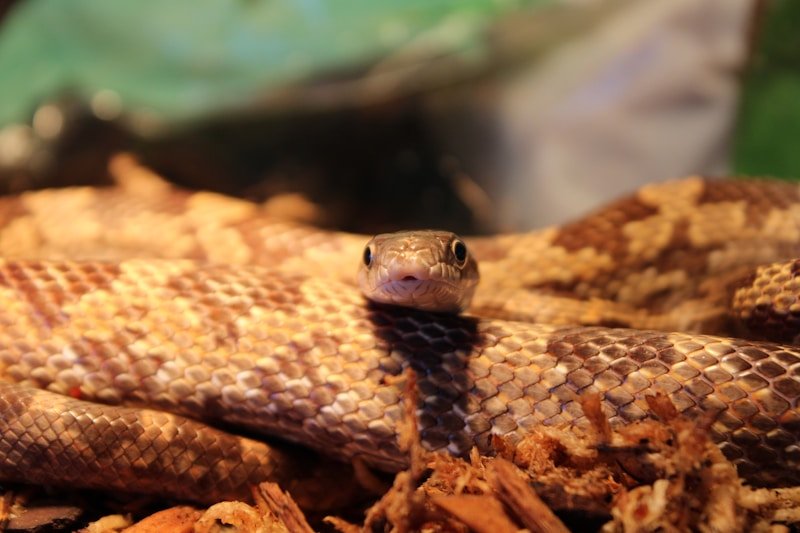Venomous snakes are found all over the world and can pose serious threats to humans and animals. Understanding the various types of venomous snakes, their risks, and how to survive a bite is crucial for anyone who lives in areas where these creatures are common. In this article, we’ll delve into the identification of venomous snakes, the risks they pose, and provide helpful survival tips in case of an encounter.
Identifying Venomous Snakes
One of the most important skills for anyone living in snake-prone areas is the ability to identify venomous species. Not all snakes are dangerous, and many non-venomous species can closely resemble venomous ones. However, there are a few key traits to look for that can help you identify dangerous snakes.
Shape of the Head: Venomous snakes often have a distinct, triangular-shaped head, especially those in the viper and pit viper families. For example, rattlesnakes, copperheads, and cottonmouths all share this feature. Non-venomous snakes tend to have more rounded heads.
Pupil Shape: Many venomous snakes, such as vipers, have vertical, slit-like pupils similar to a cat’s eye. Non-venomous snakes typically have round pupils.
Coloration and Markings: Some venomous snakes have bright, vivid colors or unique patterns. Coral snakes, for instance, have red, yellow, and black bands, while venomous pit vipers like the copperhead sport distinct hourglass-shaped patterns.
Behavior: Venomous snakes may be more aggressive when threatened, and some, like the rattlesnake, will give an audible warning before striking. Non-venomous snakes typically try to escape when approached.
By becoming familiar with these traits, you can better protect yourself and others from dangerous snake encounters.
Common Venomous Snakes
There are many venomous snake species across the globe. Here are some of the most notable ones:
Rattlesnakes (North and South America) – These snakes are often recognized by the rattle at the end of their tail, which they use to warn predators. Their venom can be lethal, but their warning system allows humans to avoid bites in many cases.
Cobras (Africa and Asia) – Known for their hoods, cobras are highly venomous and capable of delivering a fatal bite. They are often seen in mythology and folklore due to their menacing appearance and potent venom.
Black Mamba (Africa) – One of the fastest and most venomous snakes in the world, the black mamba can strike with incredible speed. Their venom can kill within hours if untreated.
Inland Taipan (Australia) – Often regarded as the most venomous snake in the world, the inland taipan’s venom can cause death in less than 30 minutes. Fortunately, it is rarely encountered due to its remote habitat.
Coral Snakes (Americas) – These brightly colored snakes, marked with red, yellow, and black bands, are often mistaken for non-venomous species. They are small but highly venomous, with bites that can be fatal if not treated promptly.
The Risks of Venomous Snake Bites
The risk associated with venomous snake bites depends on several factors, including the type of snake, the location of the bite, and how quickly medical help is received. Here are some key risks associated with snake bites:
Tissue Damage: Snake venom often contains enzymes that can destroy tissue at the bite site. If the venom spreads to muscles, blood vessels, or nerves, it can cause severe damage and even lead to amputations in extreme cases.
Systemic Effects: Some venom, particularly from snakes like cobras and mambas, affects the nervous system, causing paralysis and respiratory failure. Without immediate medical intervention, this can result in death.
Hemorrhaging: Venoms from certain species, such as vipers, contain anticoagulants that prevent blood from clotting. This can lead to uncontrolled bleeding, even internally, and can be fatal if not managed quickly.
Allergic Reactions: In rare cases, individuals may have an allergic reaction to the venom or the snake’s bite, leading to swelling, shock, or anaphylaxis.
The severity of these risks highlights the importance of knowing how to respond in the event of a snake bite.
Survival Tips: What to Do If You’re Bitten
If you are bitten by a venomous snake, quick action is critical to survival. Here are important steps to take:
Stay Calm: Panicking can increase your heart rate, which may speed up the spread of venom through your body. Try to stay as calm and still as possible.
Get Medical Help Immediately: Call emergency services or seek the nearest hospital that can provide antivenom. Time is of the essence, so don’t try to drive yourself if possible—let someone else take you.
Keep the Bite Area Below Heart Level: If possible, keep the affected limb immobilized and below the level of your heart to slow down the spread of venom. Don’t attempt to suck out the venom or cut the wound.
Remove Tight Clothing or Jewelry: If the bite occurs near an area where clothing or jewelry is tight (such as a wrist or ankle), remove it immediately to allow for proper blood circulation and avoid restricting the swelling.
Do Not Use Ice or Tourniquets: These methods are outdated and ineffective. They can cause more harm than good, so avoid them at all costs.
Conclusion
Venomous snakes are a fascinating but dangerous part of the natural world. By learning to identify these snakes, understanding the risks associated with their bites, and knowing how to react in the event of a snake bite, you can protect yourself and others from harm. While snake bites are relatively rare, being prepared and staying aware of your surroundings can make all the difference.

